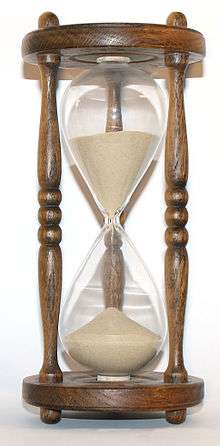Atomic clock
An atomic clock is a clock device (time standard) that uses a hyperfine transition frequency in the microwave, or electron transition frequency in the optical or ultraviolet region[2] of the electromagnetic spectrum of atoms as a frequency standard for its timekeeping element. Atomic clocks are the most accurate time and frequency standards known, and are used as primary standards for international time distribution services, to control the wave frequency of television broadcasts, and in global navigation satellite systems such as GPS.
| Atomic clock | |
|---|---|
 FOCS 1, a continuous cold caesium fountain atomic clock in Switzerland, started operating in 2004 at an uncertainty of one second in 30 million years. | |
| Classification | Clock |
| Industry | Telecommunications, science |
| Application | TAI, satellite navigation |
| Fuel source | Electricity |
| Powered | Yes |
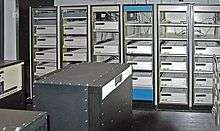
The principle of operation of an atomic clock is based on atomic physics; it measures the electromagnetic signal that electrons in atoms emit when they change energy levels. Early atomic clocks were based on masers at room temperature. Since 2004, more accurate atomic clocks first cool the atoms to near absolute zero temperature by slowing them with lasers and probing them in atomic fountains in a microwave-filled cavity. An example of this is the NIST-F1 atomic clock, one of the national primary time and frequency standards of the United States.
The accuracy of an atomic clock depends on two factors: the first is temperature of the sample atoms—colder atoms move much more slowly, allowing longer probe times, the second is the frequency and intrinsic linewidth of the electronic or hyperfine transition. Higher frequencies and narrow lines increase the precision.
National standards agencies in many countries maintain a network of atomic clocks which are intercompared and kept synchronized to an accuracy of 10−9 seconds per day (approximately 1 part in 1014). These clocks collectively define a continuous and stable time scale, the International Atomic Time (TAI). For civil time, another time scale is disseminated, Coordinated Universal Time (UTC). UTC is derived from TAI, but has added leap seconds from UT1, to account for variations in the rotation of the Earth with respect to the solar time.
History
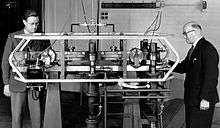
The idea of using atomic transitions to measure time was suggested by Lord Kelvin in 1879.[3] Magnetic resonance, developed in the 1930s by Isidor Rabi, became the practical method for doing this.[4] In 1945, Rabi first publicly suggested that atomic beam magnetic resonance might be used as the basis of a clock.[5] The first atomic clock was an ammonia absorption line device at 23870.1 MHz built in 1949 at the U.S. National Bureau of Standards (NBS, now NIST). It was less accurate than existing quartz clocks, but served to demonstrate the concept.[6] The first accurate atomic clock, a caesium standard based on a certain transition of the caesium-133 atom, was built by Louis Essen and Jack Parry in 1955 at the National Physical Laboratory in the UK.[7][8] Calibration of the caesium standard atomic clock was carried out by the use of the astronomical time scale ephemeris time (ET).[9] In 1967, this led the scientific community to redefine the second in terms of a specific atomic frequency. Equality of the ET second with the (atomic clock) SI second has been verified to within 1 part in 1010.[10] The SI second thus inherits the effect of decisions by the original designers of the ephemeris time scale, determining the length of the ET second.
Since the beginning of development in the 1950s, atomic clocks have been based on the hyperfine transitions in hydrogen-1, caesium-133, and rubidium-87. The first commercial atomic clock was the Atomichron, manufactured by the National Company. More than 50 were sold between 1956 and 1960. This bulky and expensive instrument was subsequently replaced by much smaller rack-mountable devices, such as the Hewlett-Packard model 5060 caesium frequency standard, released in 1964.[4]
In the late 1990s, four factors contributed to major advances in clocks:[11]
- Laser cooling and trapping of atoms
- So-called high-finesse Fabry–Pérot cavities for narrow laser line widths
- Precision laser spectroscopy
- Convenient counting of optical frequencies using optical combs.
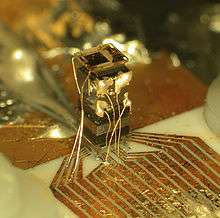
In August 2004, NIST scientists demonstrated a chip-scale atomic clock.[12] According to the researchers, the clock was believed to be one-hundredth the size of any other. It requires no more than 125 mW,[13] making it suitable for battery-driven applications. This technology became available commercially in 2011.[13] Ion trap experimental optical clocks are more precise than the current caesium standard.
In April 2015, NASA announced that it planned to deploy a Deep Space Atomic Clock (DSAC), a miniaturized, ultra-precise mercury-ion atomic clock, into outer space. NASA said that the DSAC would be much more stable than other navigational clocks.[14]
Mechanism
Since 1968, the International System of Units (SI) has defined the second as the duration of 9192631770 cycles of radiation corresponding to the transition between two energy levels of the ground state of the caesium-133 atom. In 1997, the International Committee for Weights and Measures (CIPM) added that the preceding definition refers to a caesium atom at rest at a temperature of absolute zero.[15]
This definition makes the caesium oscillator the primary standard for time and frequency measurements, called the caesium standard. The definitions of other physical units, e.g., the volt and the metre, rely on the definition of the second.[16]
In this particular design, the time-reference of an atomic clock consists of an electronic oscillator operating at microwave frequency. The oscillator is arranged so that its frequency-determining components include an element that can be controlled by a feedback signal. The feedback signal keeps the oscillator tuned in resonance with the frequency of the hyperfine transition of caesium or rubidium.
The core of the radio frequency atomic clock is a tunable microwave cavity containing a gas. In a hydrogen maser clock the gas emits microwaves (the gas mases) on a hyperfine transition, the field in the cavity oscillates, and the cavity is tuned for maximum microwave amplitude. Alternatively, in a caesium or rubidium clock, the beam or gas absorbs microwaves and the cavity contains an electronic amplifier to make it oscillate. For both types the atoms in the gas are prepared in one hyperfine state prior to filling them into the cavity. For the second type the number of atoms which change hyperfine state is detected and the cavity is tuned for a maximum of detected state changes.
Most of the complexity of the clock lies in this adjustment process. The adjustment tries to correct for unwanted side-effects, such as frequencies from other electron transitions, temperature changes, and the spreading in frequencies caused by ensemble effects. One way of doing this is to sweep the microwave oscillator's frequency across a narrow range to generate a modulated signal at the detector. The detector's signal can then be demodulated to apply feedback to control long-term drift in the radio frequency. In this way, the quantum-mechanical properties of the atomic transition frequency of the caesium can be used to tune the microwave oscillator to the same frequency, except for a small amount of experimental error. When a clock is first turned on, it takes a while for the oscillator to stabilize. In practice, the feedback and monitoring mechanism is much more complex.
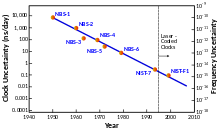
A number of other atomic clock schemes used for other purposes. Rubidium standard clocks are prized for their low cost, small size (commercial standards are as small as 17 cm3)[13] and short-term stability. They are used in many commercial, portable and aerospace applications. Hydrogen masers (often manufactured in Russia) have superior short-term stability compared to other standards, but lower long-term accuracy.
Often, one standard is used to fix another. For example, some commercial applications use a rubidium standard periodically corrected by a global positioning system receiver (see GPS disciplined oscillator). This achieves excellent short-term accuracy, with long-term accuracy equal to (and traceable to) the U.S. national time standards.
The lifetime of a standard is an important practical issue. Modern rubidium standard tubes last more than ten years, and can cost as little as US$50. Caesium reference tubes suitable for national standards currently last about seven years and cost about US$35,000. The long-term stability of hydrogen maser standards decreases because of changes in the cavity's properties over time.
Modern clocks use magneto-optical traps to cool the atoms for improved precision.
Power consumption
The power consumption of atomic clocks varies with their size. Atomic clocks on the scale of one chip require less than 30 milliwatt;[17] Primary frequency and time standards like the United States Time Standard atomic clocks, NIST-F1 and NIST-F2, use far higher power.[12][18]
Evaluated accuracy
The evaluated accuracy uB reports of various primary frequency and time standards are published online by the International Bureau of Weights and Measures (BIPM). Several frequency and time standards groups as of 2015 reported uB values in the 2 × 10−16 to 3 × 10−16 range.[19]
In 2011, the NPL-CsF2 caesium fountain clock operated by the National Physical Laboratory (NPL), which serves as the United Kingdom primary frequency and time standard, was improved regarding the two largest sources of measurement uncertainties — distributed cavity phase and microwave lensing frequency shifts. In 2011 this resulted in an evaluated frequency uncertainty reduction from uB = 4.1 × 10−16 to uB = 2.3 × 10−16;— the lowest value for any primary national standard at the time.[20] At this frequency uncertainty, the NPL-CsF2 is expected to neither gain nor lose a second in about 138 million (138 × 106) years.[21][22][23]
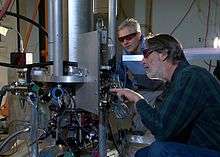
The NIST-F2 caesium fountain clock operated by the National Institute of Standards and Technology (NIST), was officially launched in April 2014, to serve as a new U.S. civilian frequency and time standard, along with the NIST-F1 standard. The planned uB performance level of NIST-F2 is 1 × 10−16.[24] "At this planned performance level the NIST-F2 clock will not lose a second in at least 300 million years."[25] NIST-F2 was designed using lessons learned from NIST-F1. The NIST-F2 key advance compared to the NIST-F1 is that the vertical flight tube is now chilled inside a container of liquid nitrogen, at −193 °C (−315.4 °F). This cycled cooling dramatically lowers the background radiation and thus reduces some of the very small measurement errors that must be corrected in NIST-F1.[26][27]
The first in-house accuracy evaluation of NIST-F2 reported a uB of 1.1 × 10−16.[28] However, a published scientific criticism of that NIST F-2 accuracy evaluation described problems in its treatment of distributed cavity phase shifts and the microwave lensing frequency shift,[29] which is treated significantly differently than in the majority of accurate fountain clock evaluations. The next NIST-F2 submission to the BIPM in March, 2015 again reported a uB of 1.5 × 10−16,[30] but did not address the standing criticism. There have been neither subsequent reports to the BIPM from NIST-F2 nor has an updated accuracy evaluation been published.
At the request of the Italian standards organization, NIST fabricated many duplicate components for a second version of NIST-F2, known as IT-CsF2 to be operated by the Istituto Nazionale di Ricerca Metrologica (INRiM), NIST's counterpart in Turin, Italy. As of February 2016 the IT-CsF2 caesium fountain clock started reporting a uB of 1.7 × 10−16 in the BIPM reports of evaluation of primary frequency standards.[31][32]
Research

.jpg)
Most research focuses on the often conflicting goals of making the clocks smaller, cheaper, more portable, more energy efficient, more accurate, more stable and more reliable.[34] The Atomic Clock Ensemble in Space is an example of clock research.[35][36]
Secondary representations of the second
A list of frequencies recommended for secondary representations of the second is maintained by the International Bureau of Weights and Measures (BIPM) since 2006 and is available online. The list contains the frequency values and the respective standard uncertainties for the rubidium microwave transition and for several optical transitions. These secondary frequency standards are accurate at the level of parts in 10−18; however, the uncertainties provided in the list are in the range of parts in 10−14 – 10−15 since they are limited by the linking to the caesium primary standard that currently (2015) defines the second.
| Type | working frequency in Hz |
relative Allan deviation typical clocks | |
|---|---|---|---|
| 133Cs | 9 192 631 770 | by definition[37] | 10−13 |
| 87Rb | 6 834 682 610 | .904 324[38] | 10−12 |
| 1H | 1 420 405 751 | .7667[39][40] | 10−15 |
| Optical clock (87Sr) | 429 228 004 229 873 | .4[41] | 10−17 |
For context, a femtosecond (1×10−15 s) is to a second what a second is to about 31.71 million (31.71×106) years and an attosecond (1×10−18 s) is to a second what a second is to about 31.71 billion (31.71×109) years.
21st century experimental atomic clocks that provide non-caesium-based secondary representations of the second are becoming so precise that they are likely to be used as extremely sensitive detectors for other things besides measuring frequency and time. For example, the frequency of atomic clocks is altered slightly by gravity, magnetic fields, electrical fields, force, motion, temperature and other phenomena. The experimental clocks tend to continue improving, and leadership in performance has been shifted back and forth between various types of experimental clocks.
Quantum clocks
In March 2008, physicists at NIST described a quantum logic clock based on individual ions of beryllium and aluminium. This clock was compared to NIST's mercury ion clock. These were the most accurate clocks that had been constructed, with neither clock gaining nor losing time at a rate that would exceed a second in over a billion years.[42] In February 2010, NIST physicists described a second, enhanced version of the quantum logic clock based on individual ions of magnesium and aluminium. Considered the world's most precise clock in 2010 with a fractional frequency inaccuracy of 8.6 × 10−18, it offers more than twice the precision of the original.[43][44] In July 2019, NIST scientists demonstrated such an Al+ Quantum-Logic clock with total uncertainty of 9.4 × 10−19, which is the first demonstration of such a clock with uncertainty below 10−18.[45][46][47] [48]
The accuracy of experimental quantum clocks has since been superseded by experimental optical lattice clocks based on strontium-87 and ytterbium-171.
Optical clocks
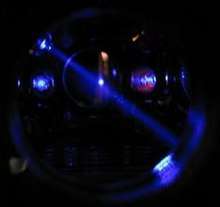
The theoretical move from microwaves as the atomic "escapement" for clocks to light in the optical range (harder to measure but offering better performance) earned John L. Hall and Theodor W. Hänsch the Nobel Prize in Physics in 2005. One of 2012's Physics Nobelists, David J. Wineland, is a pioneer in exploiting the properties of a single ion held in a trap to develop clocks of the highest stability.
New technologies, such as femtosecond frequency combs, optical lattices, and quantum information, have enabled prototypes of next-generation atomic clocks. These clocks are based on optical rather than microwave transitions. A major obstacle to developing an optical clock is the difficulty of directly measuring optical frequencies. This problem has been solved with the development of self-referenced mode-locked lasers, commonly referred to as femtosecond frequency combs. Before the demonstration of the frequency comb in 2000, terahertz techniques were needed to bridge the gap between radio and optical frequencies, and the systems for doing so were cumbersome and complicated. With the refinement of the frequency comb, these measurements have become much more accessible and numerous optical clock systems are now being developed around the world.
As in the radio range, absorption spectroscopy is used to stabilize an oscillator—in this case a laser. When the optical frequency is divided down into a countable radio frequency using a femtosecond comb, the bandwidth of the phase noise is also divided by that factor. Although the bandwidth of laser phase noise is generally greater than stable microwave sources, after division it is less.
The primary systems under consideration for use in optical frequency standards are:
- single ions isolated in an ion trap;
- neutral atoms trapped in an optical lattice and[50][51]
- atoms packed in a three-dimensional quantum gas optical lattice.
These techniques allow the atoms or ions to be highly isolated from external perturbations, thus producing an extremely stable frequency reference.
Atomic systems under consideration include Al+, Hg+/2+,[50] Hg, Sr, Sr+/2+, In+/3+, Mg, Ca, Ca+, Yb+/2+/3+, Yb and Th+/3+.[52][53][54]
.jpg)
The rare-earth element ytterbium (Yb) is valued not so much for its mechanical properties but for its complement of internal energy levels. "A particular transition in Yb atoms, at a wavelength of 578 nm, currently provides one of the world's most accurate optical atomic frequency standards," said Marianna Safronova.[55] The estimated amount of uncertainty achieved corresponds to a Yb clock uncertainty of about one second over the lifetime of the universe so far, 15 billion years, according to scientists at the Joint Quantum Institute (JQI) and the University of Delaware in December 2012.
In 2013 optical lattice clocks (OLCs) were shown to be as good as or better than caesium fountain clocks. Two optical lattice clocks containing about 10 000 atoms of strontium-87 were able to stay in synchrony with each other at a precision of at least 1.5 × 10−16, which is as accurate as the experiment could measure.[56] These clocks have been shown to keep pace with all three of the caesium fountain clocks at the Paris Observatory. There are two reasons for the possibly better precision. Firstly, the frequency is measured using light, which has a much higher frequency than microwaves, and secondly, by using many atoms, any errors are averaged.[57] Using ytterbium-171 atoms, a new record for stability with a precision of 1.6×10−18 over a 7-hour period was published on 22 August 2013. At this stability, the two optical lattice clocks working independently from each other used by the NIST research team would differ less than a second over the age of the universe (13.8×109 years); this was 10 times better than previous experiments. The clocks rely on 10 000 ytterbium atoms cooled to 10 microkelvin and trapped in an optical lattice. A laser at 578 nm excites the atoms between two of their energy levels.[58] Having established the stability of the clocks, the researchers are studying external influences and evaluating the remaining systematic uncertainties, in the hope that they can bring the clock's accuracy down to the level of its stability.[59] An improved optical lattice clock was described in a 2014 Nature paper.[60] In 2015 JILA evaluated the absolute frequency uncertainty of a strontium-87 optical lattice clock at 2.1 × 10−18, which corresponds to a measurable gravitational time dilation for an elevation change of 2 cm (0.79 in) on planet Earth that according to JILA/NIST Fellow Jun Ye is "getting really close to being useful for relativistic geodesy".[61][62][63] At this frequency uncertainty, this JILA optical lattice clock is expected to neither gain nor lose a second in more than 15 billion (15 × 109) years.[64][65]
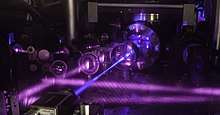
In 2017 JILA reported an experimental 3D quantum gas strontium optical lattice clock in which strontium-87 atoms are packed into a tiny three-dimensional (3-D) cube at 1,000 times the density of previous one-dimensional (1-D) clocks, like the 2015 JILA clock. A synchronous clock comparison between two regions of the 3D lattice yielded a record level of synchronization of 5 × 10−19 in 1 hour of averaging time.[66] The 3D quantum gas strontium optical lattice clock's centerpiece is an unusual state of matter called a degenerate Fermi gas (a quantum gas for Fermi particles). The experimental data shows the 3D quantum gas clock achieved a precision of 3.5 × 10−19 in about two hours. According to Jun Ye "This represents a significant improvement over any previous demonstrations." Ye further commented "The most important potential of the 3D quantum gas clock is the ability to scale up the atom numbers, which will lead to a huge gain in stability." and "The ability to scale up both the atom number and coherence time will make this new-generation clock qualitatively different from the previous generation."[67][68][69] In 2018 JILA reported the 3D quantum gas clock reached a frequency precision of 2.5 × 10−19 over 6 hours.[70][71] At this frequency uncertainty, this 3D quantum gas clock would lose or gain about 0.1 seconds over the age of the universe.[72]
Optical clocks are currently (2019) still primarily research projects, less mature than rubidium and caesium microwave standards, which regularly deliver time to the International Bureau of Weights and Measures (BIPM) for establishing International Atomic Time (TAI).[73] As the optical experimental clocks move beyond their microwave counterparts in terms of accuracy and stability performance this puts them in a position to replace the current standard for time, the caesium fountain clock.[50][74] In the future this might lead to redefine the caesium microwave based SI second and other new dissemination techniques at the highest level of accuracy to transfer clock signals will be required that can be used in both shorter-range and longer-range (frequency) comparisons between better clocks and to explore their fundamental limitations without significantly compromising their performance.[50][75][76][77][78]
Nuclear (optical) clock concept
One theoretical possibility for improving the performance of atomic clocks is to use a nuclear energy transition (between different nuclear isomers) rather than the atomic electron transitions which current atomic clocks measure. Most nuclear transitions operate at far too high a frequency to be measured, but in 2003, Ekkehard Peik and Christian Tamm[79] noted that the exceptionally low excitation energy of 229m
Th
is within reach of current frequency-measurement techniques, making a clock possible. In 2012 it was shown, that a nuclear clock based on a single 229
Th3+
ion could provide a total fractional frequency inaccuracy of 1.5 × 10−19, which is better than existing 2019 atomic clock technology.[80] Although it remains an unrealized theoretical possibility, as of 2019 significant progress toward the development of an experimental nuclear clock has been made.[81][82][83][84]
A nuclear energy transition offers the following potential advantages:[85]
- Higher frequency. All other things being equal, a higher-frequency transition offers greater stability for simple statistical reasons (fluctuations are averaged over more cycles per second).
- Immunity to environmental effects. Due to its small size and the shielding effects of the surrounding electrons, an atomic nucleus is much less sensitive to ambient electromagnetic fields than an electron.
- Greater numbers of atoms. Because of the aforementioned immunity to ambient fields, it is not necessary to have the clock atoms well-separated in a dilute gas. In fact, it would be possible to take advantage of the Mössbauer effect and place the atoms in a solid, which would allow billions of atoms to be interrogated.
Clock comparison techniques
In June 2015, the European National Physical Laboratory (NPL) in Teddington, UK; the French department of Time-Space Reference Systems at the Paris Observatory (LNE-SYRTE); the German German National Metrology Institute (PTB) in Braunschweig; and Italy's Istituto Nazionale di Ricerca Metrologica (INRiM) in Turin labs have started tests to improve the accuracy of current state-of-the-art satellite comparisons by a factor 10, but it will still be limited to one part in 1 × 10−16. These 4 European labs are developing and host a variety of experimental optical clocks that harness different elements in different experimental set-ups and want to compare their optical clocks against each other and check whether they agree. In a next phase these labs strive to transmit comparison signals in the visible spectrum through fibre-optic cables. This will allow their experimental optical clocks to be compared with an accuracy similar to the expected accuracies of the optical clocks themselves. Some of these labs have already established fibre-optic links, and tests have begun on sections between Paris and Teddington, and Paris and Braunschweig. Fibre-optic links between experimental optical clocks also exist between the American NIST lab and its partner lab JILA, both in Boulder, Colorado but these span much shorter distances than the European network and are between just two labs. According to Fritz Riehle, a physicist at PTB, "Europe is in a unique position as it has a high density of the best clocks in the world".[86] In August 2016 the French LNE-SYRTE in Paris and German PTB in Braunschweig reported the comparison and agreement of two fully independent experimental strontium lattice optical clocks in Paris and Braunschweig at an uncertainty of 5 × 10−17 via a newly established phase-coherent frequency link connecting Paris and Braunschweig, using 1,415 km (879 mi) of telecom fibre-optic cable. The fractional uncertainty of the whole link was assessed to be 2.5 × 10−19, making comparisons of even more accurate clocks possible.[87][88]
Applications
The development of atomic clocks has led to many scientific and technological advances such as a system of precise global and regional navigation satellite systems, and applications in the Internet, which depend critically on frequency and time standards. Atomic clocks are installed at sites of time signal radio transmitters. They are used at some long wave and medium wave broadcasting stations to deliver a very precise carrier frequency. Atomic clocks are used in many scientific disciplines, such as for long-baseline interferometry in radioastronomy.[89]
Global Navigation Satellite Systems
The Global Positioning System (GPS) operated by the US Air Force Space Command provides very accurate timing and frequency signals. A GPS receiver works by measuring the relative time delay of signals from a minimum of four, but usually more, GPS satellites, each of which has at least two onboard caesium and as many as two rubidium atomic clocks. The relative times are mathematically transformed into three absolute spatial coordinates and one absolute time coordinate.[90] GPS Time (GPST) is a continuous time scale and theoretically accurate to about 14 ns.[91] However, most receivers lose accuracy in the interpretation of the signals and are only accurate to 100 ns.[92][93] The GPST is related to but differs from TAI (International Atomic Time) and UTC (Coordinated Universal Time). GPST remains at a constant offset with TAI (TAI – GPST = 19 seconds) and like TAI does not implement leap seconds. Periodic corrections are performed to the on-board clocks in the satellites to keep them synchronized with ground clocks.[94][95] The GPS navigation message includes the difference between GPST and UTC. As of July 2015, GPST is 17 seconds ahead of UTC because of the leap second added to UTC on 30 June 2015.[96][97] Receivers subtract this offset from GPS Time to calculate UTC and specific time zone values.
The GLObal NAvigation Satellite System (GLONASS) operated by the Russian Aerospace Defence Forces provides an alternative to the Global Positioning System (GPS) system and is the second navigational system in operation with global coverage and of comparable precision. GLONASS Time (GLONASST) is generated by the GLONASS Central Synchroniser and is typically better than 1,000 ns.[98] Unlike GPS, the GLONASS time scale implements leap seconds, like UTC.[99]
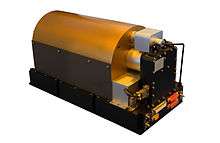
The Galileo Global Navigation Satellite System is operated by the European GNSS Agency and European Space Agency and is near to achieving full operating global coverage. Galileo started offering global Early Operational Capability (EOC) on 15 December 2016, providing the third and first non-military operated Global Navigation Satellite System, and is expected to reach Full Operational Capability (FOC) in 2019.[100][101] To achieve Galileo's FOC coverage constellation goal 6 planned extra satellites need to be added. Galileo System Time (GST) is a continuous time scale which is generated on the ground at the Galileo Control Centre in Fucino, Italy, by the Precise Timing Facility, based on averages of different atomic clocks and maintained by the Galileo Central Segment and synchronised with TAI with a nominal offset below 50 ns.[102][103][104][101] According to the European GNSS Agency Galileo offers 30 ns timing accuracy.[105] The March 2018 Quarterly Performance Report by the European GNSS Service Centre reported the UTC Time Dissemination Service Accuracy was ≤ 7.6 ns, computed by accumulating samples over the previous 12 months and exceeding the ≤ 30 ns target.[106][107] Each Galileo satellite has two passive hydrogen maser and two rubidium atomic clocks for onboard timing.[108][109] The Galileo navigation message includes the differences between GST, UTC and GPST (to promote interoperability).[110][111]
The BeiDou-2/BeiDou-3 satellite navigation system is operated by the China National Space Administration and is also near to achieving full-scale global coverage. BeiDou Time (BDT) is a continuous time scale starting at 1 January 2006 at 0:00:00 UTC and is synchronised with UTC within 100 ns.[112][113] BeiDou became operational in China in December 2011, with 10 satellites in use,[114] and began offering services to customers in the Asia-Pacific region in December 2012.[115] On 27 December 2018 the BeiDou Navigation Satellite System started to provide global services with a reported timing accuracy of 20 ns.[116] The BeiDou global navigation system should be finished by 2020.[117]
Time signal radio transmitters
A radio clock is a clock that automatically synchronizes itself by means of government radio time signals received by a radio receiver. Many retailers market radio clocks inaccurately as atomic clocks;[118] although the radio signals they receive originate from atomic clocks, they are not atomic clocks themselves. Normal low cost consumer grade receivers solely rely on the amplitude-modulated time signals and use narrow band receivers (with 10 Hz bandwidth) with small ferrite loopstick antennas and circuits with non optimal digital signal processing delay and can therefore only be expected to determine the beginning of a second with a practical accuracy uncertainty of ± 0.1 second. This is sufficient for radio controlled low cost consumer grade clocks and watches using standard-quality quartz clocks for timekeeping between daily synchronization attempts, as they will be most accurate immediately after a successful synchronization and will become less accurate from that point forward until the next synchronization.[119] Instrument grade time receivers provide higher accuracy. Such devices incur a transit delay of approximately 1 ms for every 300 kilometres (186 mi) of distance from the radio transmitter. Many governments operate transmitters for time-keeping purposes.
See also
References
- USNO Master Clock
- McCarthy, Dennis; Seidelmann, P. Kenneth (2009). TIME from Earth Rotation to Atomic Physics. Weinheim: Wiley-VCH. ch. 10 & 11.
- Thomson, William; Tait, Peter Guthrie (1879). Treatise on Natural Philosophy. 1, part 1 (2nd ed.). Cambridge, England: Cambridge University Press. p. 227.
- M.A. Lombardi; T.P. Heavner; S.R. Jefferts (2007). "NIST Primary Frequency Standards and the Realization of the SI Second" (PDF). Journal of Measurement Science. 2 (4): 74.
- See:
- Isidor I. Rabi, "Radiofrequency spectroscopy" (Richtmyer Memorial Lecture, delivered at Columbia University in New York, New York, on 20 January 1945).
- "Meeting at New York, January 19 and 20, 1945" Physical Review, vol. 67, pages 199-204 (1945).
- Laurence, William L. (2007). "NIST primary frequency standards and the realization of the SI second" (PDF). NCSLI Measure. 2 (4): 74–89. doi:10.1080/19315775.2007.11721402.
- D.B. Sullivan (2001). "Time and frequency measurement at NIST: The first 100 years" (PDF). 2001 IEEE International Frequency Control Symposium. NIST. pp. 4–17.
- Essen, L.; Parry, J. V. L. (1955). "An Atomic Standard of Frequency and Time Interval: A Cæsium Resonator". Nature. 176 (4476): 280–282. Bibcode:1955Natur.176..280E. doi:10.1038/176280a0.
- "60 years of the Atomic Clock". National Physical Laboratory. Retrieved 17 October 2017.
- W. Markowitz; R.G. Hall; L. Essen; J.V.L. Parry (1958). "Frequency of cesium in terms of ephemeris time". Physical Review Letters. 1 (3): 105–107. Bibcode:1958PhRvL...1..105M. doi:10.1103/PhysRevLett.1.105.
- W. Markowitz (1988). "Comparisons of ET(Solar), ET(Lunar), UT and TDT'". In A.K. Babcock; G.A. Wilkins (eds.). The Earth's Rotation and Reference Frames for Geodesy and Geophysics, International Astronomical Union Symposia #128. pp. 413–418.. Pages 413–414, gives the information that the SI second was made equal to the second of ephemeris time as determined from lunar observations, and was later verified in this relation, to 1 part in 1010.
- J. Ye; H. Schnatz; L.W. Hollberg (2003). "Optical frequency combs: From frequency metrology to optical phase control" (PDF). IEEE Journal of Selected Topics in Quantum Electronics. 9 (4): 1041. doi:10.1109/JSTQE.2003.819109.
- "Chip-Scale Atomic Devices at NIST". NIST. 2007. Archived from the original on 7 January 2008. Retrieved 17 January 2008. Available on-line at: NIST.gov
- "SA.45s CSAC Chip Scale Atomic Clock (archived version of the original pdf)" (PDF). 2011. Archived from the original (PDF) on 25 May 2013. Retrieved 12 June 2013.
- Landau, Elizabeth (27 April 2015). "Deep Space Atomic Clock". NASA. Retrieved 29 April 2015.
- "International System of Units (SI)" (PDF) (8th ed.). International Bureau of Weights and Measures (BIPM). 2006.
- "FAQs". Franklin Instrument Company. 2007. Archived from the original on 17 December 2000. Retrieved 17 January 2008.
- Lutwak, Robert (26–29 November 2007). "The Chip-Scale Atomic Clock — Prototype Evaluation". 36th Annual Precise Time and Time Interval (PTTI) Systems and Applications Meeting.
- "NIST Launches a New U.S. Time Standard: NIST-F2 Atomic Clock". nist.gov.
- BIPM Annual Report on Time Activities, Volume 10, 2015, ISBN 978-92-822-2263-8, ISSN 1994-9405
- Evaluation of the frequency of the H-maser 1401708 by the primary frequency standard NPL-CsF2, National Physical Laboratory, February 2010
- "NPL's atomic clock revealed to be the world's most accurate : News : News + Events : National Physical Laboratory". npl.co.uk.
- "NPL-CsF2: now the atomic clock with the world's best long-term accuracy - Science Codex". sciencecodex.com.
- Li, Ruoxin; Gibble, Kurt; Szymaniec, Krzysztof (2011). "Improved accuracy of the NPL-CsF2 primary frequency standard: Evaluation of distributed cavity phase and microwave lensing frequency shifts". Metrologia. 48 (5): 283–289. arXiv:1107.2412. Bibcode:2011Metro..48..283L. doi:10.1088/0026-1394/48/5/007.
- S.R. Jefferts; T.P. Heavner; T.E. Parker; J.H. Shirley (2007). "NIST Cesium Fountains − Current Status and Future Prospects". Acta Physica Polonica A. 112 (5): 759 ff. Bibcode:2007AcPPA.112..759J. doi:10.12693/APhysPolA.112.759.
- "Time gets an upgrade". New Scientist: 7. 12 April 2014.
- "NIST launches a new US time standard: NIST-F2 atomic clock". nist.gov. 3 April 2014. Retrieved 3 April 2014.
- "Background: How NIST-F2 Works". nist.gov. 2 April 2014. Retrieved 4 April 2014.
- Heavner T P, Donley E A, Levi F, Costanzo G, Parker TE, Shirley J H, Ashby N, Barlow S and Jefferts SR, "First accuracy evaluation of NIST-F2," 2014 Metrologia 51, 174–182, May 2014
- Li, Ruoxin; Gibble, Kurt; Szymaniec, Krzysztof (2015). "Comment on "first accuracy evaluation of NIST-F2"". Metrologia. 52 (2015): 163–166. arXiv:1505.00649. Bibcode:2015Metro..52..163G. doi:10.1088/0026-1394/52/1/163.
- [ February/March 2015 Evaluation of NIST-F2]
- February 2016 IT-CsF2 TAI evaluation
- June 2018 IT-CsF2 TAI evaluation
- "President Piñera Receives ESO's First Atomic Clock". ESO Announcement. 15 November 2013. Retrieved 20 November 2013.
- Laura Ost (4 February 2014). "A New Era for Atomic Clocks". National Institute of Standards and Technology. Retrieved 18 October 2015.
- ESA. "Atomic clock ensemble in space (ACES)" (PDF). ERASMUS Centre - Directorate of Human Spaceflight and Operations. Retrieved 11 February 2017.
- "With better atomic clocks, scientists prepare to redefine the second". Science | AAAS. 28 February 2018. Retrieved 2 March 2018.
- "Unit of time (second)". SI Brochure. BIPM. 2014 [2006]. Retrieved 23 June 2015.
- 87Rubidium BIPM document
- Essen, L; Donaldson, R W; Hope, E G; Bangham, M J (July 1973). "Hydrogen Maser Work at the National Physical Laboratory". Metrologia. 9 (3): 128–137. Bibcode:1973Metro...9..128E. doi:10.1088/0026-1394/9/3/004.
- Dupays, Arnaud; Beswick, Alberto; Lepetit, Bruno; Rizzo, Carlo (August 2003). "Proton Zemach radius from measurements of the hyperfine splitting of hydrogen and muonic hydrogen" (PDF). Physical Review A. 68 (5): 052503. arXiv:quant-ph/0308136. Bibcode:2003PhRvA..68e2503D. doi:10.1103/PhysRevA.68.052503.
- 87Strontium BIPM document
- Swenson, Gayle (7 June 2010). "Press release: NIST 'Quantum Logic Clock' Rivals Mercury Ion as World's Most Accurate Clock". NIST.
- NIST's Second 'Quantum Logic Clock' Based on Aluminum Ion is Now World's Most Precise Clock, NIST, 4 February 2010
- C.W Chou; D. Hume; J.C.J. Koelemeij; D.J. Wineland & T. Rosenband (17 February 2010). "Frequency Comparison of Two High-Accuracy Al+ Optical Clocks" (PDF). NIST. 104: 070802. doi:10.1103/PhysRevLett.104.070802. PMID 20366869. Retrieved 9 February 2011.
- Brewer, S. M.; Chen, J.-S.; Hankin, A. M.; Clements, E. R.; Chou, C. W.; Wineland, D. J.; Hume, D. B.; Leibrandt, D. R. (15 July 2019). "Al + 27 Quantum-Logic Clock with a Systematic Uncertainty below 10 − 18". Physical Review Letters. 123 (3): 033201. arXiv:1902.07694. doi:10.1103/PhysRevLett.123.033201. PMID 31386450.
- Wills, Stewart (July 2019). "Optical Clock Precision Breaks New Ground".
- Dubé, Pierre (15 July 2019). "Viewpoint: Ion Clock Busts into New Precision Regime". Physics. 12. doi:10.1103/physics.12.79.
- S. M. Brewer; J.-S. Chen; A. M. Hankin; E. R. Clements; C. W. Chou; D. J. Wineland; D. B. Hume; D. R. Leibrandt (2019). "Al+ Quantum-Logic Clock with a Systematic Uncertainty below 10^-18". Phys. Rev. Lett. 123 (3): 033201. arXiv:1902.07694. doi:10.1103/PhysRevLett.123.033201. PMID 31386450.
- D. Lindley (20 May 2009). "Coping With Unusual Atomic Collisions Makes an Atomic Clock More Accurate". National Science Foundation. Retrieved 10 July 2009.
- W.H. Oskay; et al. (2006). "Single-atom optical clock with high accuracy" (PDF). Physical Review Letters. 97 (2): 020801. Bibcode:2006PhRvL..97b0801O. doi:10.1103/PhysRevLett.97.020801. PMID 16907426.
- Fritz Riehle. "On Secondary Representations of the Second" (PDF). Physikalisch-Technische Bundesanstalt, Division Optics. Archived from the original (PDF) on 23 June 2015. Retrieved 22 June 2015.
- 171Ytterbium BIPM document
- PTB Time and Frequency Department 4.4
- PTB Optical nuclear spectroscopy of 229Th
- "Blackbody Radiation Shift: Quantum Thermodynamics Will Redefine Clocks". Retrieved 5 December 2012.
- Ost, Laura (22 January 2014). "JILA Strontium Atomic Clock Sets New Records in Both Precision and Stability". NIST Tech Beat. National Institute of Standards and Technology. Retrieved 5 December 2014.
- "Precise atomic clock may redefine time". 9 July 2013. Retrieved 24 August 2013.
- "NIST Ytterbium Atomic Clocks Set Record for Stability". 22 August 2013. Retrieved 24 August 2013.
- "New atomic clock sets the record for stability". 27 August 2013. Retrieved 19 January 2014.
- Bloom, B. J.; Nicholson, T. L.; Williams, J. R.; Campbell, S. L.; Bishof, M.; Zhang, X.; Zhang, W.; Bromley, S. L.; Ye, J. (22 January 2014). "An optical lattice clock with accuracy and stability at the 10−18 level" (PDF). Nature. 506 (7486): 71–5. arXiv:1309.1137. Bibcode:2014Natur.506...71B. doi:10.1038/nature12941. PMID 24463513.
- T.L. Nicholson; S.L. Campbell; R.B. Hutson; G.E. Marti; B.J. Bloom; R.L. McNally; W. Zhang; M.D. Barrett; M.S. Safronova; G.F. Strouse; W.L. Tew; J. Ye (21 April 2015). "Systematic evaluation of an atomic clock at 2 × 10−18 total uncertainty". Nature Communications. 6 (6896): 6896. arXiv:1412.8261. Bibcode:2015NatCo...6E6896N. doi:10.1038/ncomms7896. PMC 4411304. PMID 25898253.
- JILA Scientific Communications (21 April 2015). "About Time". Archived from the original on 19 September 2015. Retrieved 27 June 2015.
- Laura Ost (21 April 2015). "Getting Better All the Time: JILA Strontium Atomic Clock Sets New Record". National Institute of Standards and Technology. Retrieved 17 October 2015.
- James Vincent (22 April 2015). "The most accurate clock ever built only loses one second every 15 billion years". The Verge. Retrieved 26 June 2015.
- N. Huntemann; C. Sanner; B. Lipphardt; Chr. Tamm; E. Peik (8 February 2016). "Single-Ion Atomic Clock with 3 × 10−18 Systematic Uncertainty". Physical Review Letters. 116 (6): 063001. arXiv:1602.03908. Bibcode:2016PhRvL.116f3001H. doi:10.1103/PhysRevLett.116.063001. PMID 26918984.
- S. L. Campbell; R. B. Hutson; G. E. Marti; A. Goban; N. Darkwah Oppong; R. L. McNally; L. Sonderhouse; W. Zhang; B. J. Bloom; J. Ye (2017). "A Fermi-degenerate three-dimensional optical lattice clock" (PDF). Science. 358 (6359): 90–94. arXiv:1702.01210. Bibcode:2017Sci...358...90C. doi:10.1126/science.aam5538. PMID 28983047. Retrieved 29 March 2017.
- Abigail Beall (5 October 2017). "A Fermi-degenerate three-dimensional optical lattice clock". Wired UK. Retrieved 29 March 2017.
- NIST (5 October 2017). "JILA's 3-D Quantum Gas Atomic Clock Offers New Dimensions in Measurement". Retrieved 29 March 2017. Cite journal requires
|journal=(help) - Julie Phillips (10 October 2017). "The Clock that Changed the World". JILA. Retrieved 30 March 2017.
- G. Edward Marti; Ross B. Hutson; Akihisa Goban; Sara L. Campbell; Nicola Poli; Jun Ye (2018). "Imaging Optical Frequencies with 100 μHz Precision and 1.1 μm Resolution" (PDF). Physical Review Letters. 120 (10): 103201. arXiv:1711.08540. Bibcode:2018PhRvL.120j3201M. doi:10.1103/PhysRevLett.120.103201. PMID 29570334. Retrieved 30 March 2017.
- Laura Ost (5 March 2018). "JILA Team Invents New Way to 'See' the Quantum World". JILA. Retrieved 30 March 2017.
- "Same Clock. New Perspective". JILA. 13 March 2018. Retrieved 23 September 2018.
- "BIPM Time Coordinated Universal Time (UTC)". BIPM. Retrieved 29 December 2013.
- N. Poli; C. W. Oates; P. Gill; G. M. Tino (13 January 2014). "Optical atomic clocks". Rivista del Nuovo Cimento. 36 (12): 555–624. arXiv:1401.2378. Bibcode:2013NCimR..36..555P. doi:10.1393/ncr/i2013-10095-x.
- "BIPM work programme: Time". BIPM. Retrieved 25 June 2015.
- Helen Margolis (12 January 2014). "Timekeepers of the future". Nature Physics. 10 (2): 82–83. Bibcode:2014NatPh..10...82M. doi:10.1038/nphys2834.
- Grebing, Christian; Al-Masoudi, Ali; Dörscher, Sören; Häfner, Sebastian; Gerginov, Vladislav; Weyers, Stefan; Lipphardt, Burghard; Riehle, Fritz; Sterr, Uwe; Lisdat, Christian (2016). "Realization of a timescale with an accurate optical lattice clock". Optica. 3 (6): 563–569. arXiv:1511.03888. doi:10.1364/OPTICA.3.000563.
- Ludlow, Andrew D; Boyd, Martin M; Ye, Jun; Peik, Ekkehard; Schmidt, Piet O (2015). "Optical atomic clocks". Reviews of Modern Physics. 87 (2): 673. arXiv:1407.3493. doi:10.1103/RevModPhys.87.637.
- Peik, E.; Tamm, Chr. (15 January 2003). "Nuclear laser spectroscopy of the 3.5 eV transition in 229Th" (PDF). Europhysics Letters. 61 (2): 181–186. Bibcode:2003EL.....61..181P. doi:10.1209/epl/i2003-00210-x. Archived from the original (PDF) on 16 December 2013. Retrieved 11 September 2019.
- Campbell, C.; Radnaev, A.G.; Kuzmich, A.; Dzuba, V.A.; Flambaum, V.V.; Derevianko, A. (2012). "A single ion nuclear clock for metrology at the 19th decimal place". Phys. Rev. Lett. 108 (12): 120802. arXiv:1110.2490. Bibcode:2012PhRvL.108l0802C. doi:10.1103/PhysRevLett.108.120802. PMID 22540568.
- von der Wense, Lars; Seiferle, Benedict; Laatiaoui, Mustapha; Neumayr, Jürgen B.; Maier, Hans-Jörg; Wirth, Hans-Friedrich; Mokry, Christoph; Runke, Jörg; Eberhardt, Klaus; Düllmann, Christoph E.; Trautmann, Norbert G.; Thirolf, Peter G. (5 May 2016). "Direct detection of the 229Th nuclear clock transition". Nature. 533 (7601): 47–51. arXiv:1710.11398. Bibcode:2016Natur.533...47V. doi:10.1038/nature17669. PMID 27147026.
- Thielking, J.; Okhapkin, M.V.; Przemyslaw, G.; Meier, D.M.; von der Wense, L.; Seiferle, B.; Düllmann, C.E.; Thirolf, P.G.; Peik, E. (2018). "Laser spectroscopic characterization of the nuclear-clock isomer 229mTh". Nature. 556 (7701): 321–325. arXiv:1709.05325. Bibcode:2018Natur.556..321T. doi:10.1038/s41586-018-0011-8. PMID 29670266.
- Masuda, T.; Yoshimi, A.; Fujieda, A.; Fujimoto, H.; Haba, H.; Hara, H.; Hiraki, T.; Kaino, H.; Kasamatsu, Y.; Kitao, S.; Konashi, K.; Miyamoto, Y.; Okai, K.; Okubo, S.; Sasao, N.; Seto, M.; Schumm, T.; Shigekawa, Y.; Suzuki, K.; Stellmer, S.; Tamasaku, K.; Uetake, S.; Watanabe, M.; Watanabe, T.; Yasuda, Y.; Yamaguchi, A.; Yoda, Y.; Yokokita, T.; Yoshimura, M.; Yoshimura, K. (12 September 2019). "X-ray pumping of the 229Th nuclear clock isomer". Nature. 573 (7773): 238–242. arXiv:1902.04823. Bibcode:2019Natur.573..238M. doi:10.1038/s41586-019-1542-3. PMID 31511686.
- Seiferle, B.; von der Wense, L.; Bilous, P.V.; Amersdorffer, I.; Lemell, C.; Libisch, F.; Stellmer, S.; Schumm, T.; Düllmann, C.E.; Pálffy, A.; Thirolf, P.G. (12 September 2019). "Energy of the 229Th nuclear clock transition". Nature. 573 (7773): 243–246. arXiv:1905.06308. Bibcode:2019Natur.573..243S. doi:10.1038/s41586-019-1533-4. PMID 31511684.
- Peik, Ekkehard (25–27 September 2012). Concepts and Prospects for a Thorium-229 Nuclear Clock (PDF). EMMI Workshop: The 229mTh Nuclear Isomer Clock. Darmstadt.
- Elizabeth Gibney (2 June 2015). "Hyper-precise atomic clocks face off to redefine time - Next-generation timekeepers can only be tested against each other". Nature. 522 (7554): 16–17. Bibcode:2015Natur.522...16G. doi:10.1038/522016a. PMID 26040875.
- Paul-Eric Pottie, Gesine Grosche (19 August 2016). "A clock network for geodesy and fundamental science". Nature Communications. 7: 12443. arXiv:1511.07735. Bibcode:2016NatCo...712443L. doi:10.1038/ncomms12443. PMC 4980484. PMID 27503795.
- Optical fibre link opens a new era of time-frequency metrology, 19 August 2016
- McCarthy, D. D.; Seidelmann, P. K. (2009). TIME—From Earth Rotation to Atomic Physics. Weinheim: Wiley-VCH Verlag GmbH & Co. KGaA. p. 266. ISBN 978-3-527-40780-4.
- "Global Positioning System". Gps.gov. Archived from the original on 30 July 2010. Retrieved 26 June 2010.
- David W. Allan (1997). "The Science of Timekeeping" (PDF). Hewlett Packard. Archived (PDF) from the original on 25 October 2012. Cite journal requires
|journal=(help) - "The Role of GPS in Precise Time and Frequency Dissemination" (PDF). GPSworld. July–August 1990. Retrieved 27 April 2014. Cite journal requires
|journal=(help) - "GPS time accurate to 100 nanoseconds". Galleon. Retrieved 12 October 2012.
- "UTC to GPS Time Correction". qps.nl.
- "NAVSTAR GPS User Equipment Introduction" (PDF). Section 1.2.2
- http://www.navcen.uscg.gov/?pageName=currentNanus&format=txt
- "Notice Advisory to Navstar Users (NANU) 2012034". GPS Operations Center. 30 May 2012. Archived from the original on 8 April 2013. Retrieved 2 July 2012.
- "Time References in GNSS". navipedia.net.
- GLONASS Interface Control Document, Navigation radiosignal In bands L1, L2 (ICD L1, L2 GLONASS), Russian Institute of Space Device Engineering, Edition 5.1, 2008
- "Galileo begins serving the globe". European Space Agency. Retrieved 15 December 2016.
- "Galileo's contribution to the MEOSAR system". European Commission. Retrieved 30 December 2015.
- European GNSS (Galileo) Open Service Signal-In-Space Operational Status Definition, Issue 1.0, September 2015
- 1 The Definition and Implementation of Galileo System Time (GST). ICG-4 WG-D on GNSS time scales. Jérôme Delporte. CNES – French Space Agency.
- "Galileo's clocks". European Space Agency. Retrieved 16 January 2017.
- "GALILEO GOES LIVE". European GNSS Agency. 15 December 2016. Retrieved 1 February 2017.
- "GALILEO INITIAL SERVICES – OPEN SERVICE – QUARTERLY PERFORMANCE REPORT OCT-NOV-DEC 2017" (PDF). European GNSS Service Centre. 28 March 2018. Retrieved 28 March 2017.
- Galileo Open Service and Search and Rescue - Quarterly Performance Reports, containing measured performance statistics
- "Passive Hydrogen Maser (PHM)". spectratime.com.
- "Rb Atomic Frequency Standard (RAFS)". spectratime.com.
- GNSS Timescale Description
- "ESA Adds System Time Offset to Galileo Navigation Message". insidegnss.com.
- China Satellite Navigation Office, Version 2.0, December 2013
- Definition and Realization of the System Time of COMPASS/BeiDou Navigation Satellite System, Chunhao Han, Beijing Global Information Center,(BGIC), Beijing, China
- "China GPS rival Beidou starts offering navigation data". BBC. 27 December 2011.
- "China's Beidou GPS-substitute opens to public in Asia". BBC. 27 December 2012. Retrieved 27 December 2012.
- PTI, K. J. M. Varma (27 December 2018). "China's BeiDou navigation satellite, rival to US GPS, starts global services". livemint.com. Retrieved 27 December 2018.
- "BeiDou navigation system covers Asia-Pacific region till 2012" (in Chinese). Xinhua News Agency. 3 March 2010. Retrieved 19 May 2010.
- Michael A. Lombardi, "How Accurate is a Radio Controlled Clock?", National Institute of Standards and Technology, 2010.
- Michael A. Lombardi, "How Accurate is a Radio Controlled Clock?, National Institute of Standards and Technology, 2010.
External links
- National Research Council Canada, FAQ: “What is a ‘cesium atomic clock’?”
- National Research Council Canada, archived content: Optical frequency standard based on a single trapped ion
- United States Naval Observatory Time Service Department
- PTB Braunschweig, Germany - with link in English language
- National Physical Laboratory (UK) time website
- NIST Internet Time Service (ITS): Set Your Computer Clock Via the Internet
- NIST press release about chip-scaled atomic clock
- NIST website
- Web pages on atomic clocks by The Science Museum (London)
- Optical Atomic Clock BBC, 2005
- Optical lattice clock; Journal of the Physical Society of Japan
- The atomic fountain
- National Research Council of Canada, archived content: Optical Frequency Comb – The Measurement of Optical Frequencies
